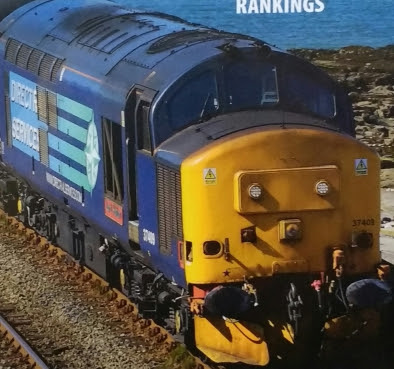Almost missed in a quick flip through fbb's new Big Bucks Bus Book was this picture.
It is, indeed, a Paris Trolleybus showing route number 163.
Trolleybi Patisiens - Ooh Là Là! So, as ever, off to Wikipedia to find out.
But to no avail - well, very little avail. Thankfully there was a "lien externale" to quite a bit of info which will provide a starter for a blog next week. For the time being, here are the introductory paragraphs.
Contrairement à la majorité des réseaux français, le trolleybus est apparu à Paris non pas pour remplacer les tramways, mais pour pallier la disparition des autobus !
Les tramways parisiens avaient disparu en 1938, sous la pression de l'industrie automobile, remplacés par des autobus. Un an plus tard, ceux-ci étaient partiellement réquisitionnés par l'Armée. Après de la défaite de 1940, le réseau d'autobus était réduit à sa plus simple expression et l'exploitation se faisait dans des conditions de précarité inimaginable.
Pour pallier partiellement cette situation, et forte d'expériences ponctuelles avant la guerre, la STCRP élaborait un plan de développement du trolleybus pour toutes les grandes radiales de banlieue.
Which, being interpreted, tells us that the Trolleybi were introduced in a desperate attempt to compensate for the loss of motor buses requisitioned by the German authorities after the 1940 defeat.
More to come in due course.
Heinous Theft at Railway Depot?
A glance at one of the cover headlines on the current edition of Modern Railways might be a real shocker. Is "growler" the pseudonym of a burglar helping himself to expensive tools from one of our major maintenance sheds?
Or is it the manager's dog?
And who gets the beer?
In fact the explanation is more prosaic. Every year Modern Railways writer Roger Ford ...
... collates performance records for all British railway motive power. A junket is held with awards to the best performing engine or multiple unit.
The awards are in the form of gold, silver and bronze spanners, although like today's Olympic medals, the metallic colour is the focus, not the particular metal!
The British Rail Class 37 is a diesel-electric locomotive. Also known as the English Electric Type 3, the Class was ordered as part of the British Rail modernisation plan. These locos were built between 1960 and 1965. One of their many nicknames in "growler".
The Class 37 became a familiar sight on many parts of the British Rail network, in particular forming the main motive power for Inter-City services in East Anglia and within Scotland. They also performed well on secondary and inter-regional services for many years. The Class 37s are known to some railway enthusiasts as "Tractors", a nickname due to the agricultural sound of the diesel engine of the locomotive.
These very old ladies were awarded a "silver spanner" for their reliability. Not bad for a 50 year old diesel!
Falcon Fandango
Yesterday, it was all happening at Plymouth coach station. The excuse for the jollification was the 150,000th passenger on the South West Falcon, Stagecoach's "courageous" express coach service between Plymouth, Exeter and Bristol.
This was the item on Stagecoach's staff newsletter.
Pat the Falcon?
Brian Souter must feel really stupid dressed like that.
fbb has "done the math" and it works out at an average of 24 passengers per journey. Bus watchers may wonder whether that is enough to make a profit!
Any thoughts from blog readers?
Map Mistake Ameliorated.
Remember the GoTimetable Sheffield bog-up? The very complicated gyrations of evening and Sunday buses in Killamarsh had bamboozled the GoTimetable's skilled cartographers. (O.K. fbb really!).
Here is the corrected version:-
It will appear on-line and on laptop early next week.
www.gotimetable.com
The first batch of Sheffield updates from 29th January will also appear; but there is no need to rush to peruse them as, with the exception of 70/71/72 (already blogged) and the reduction of the service to Penistone, most changes are the usual tweaking of timetables by a couple of minutes here and there.
Rather boring?
Rather boring?
Tomorrow, fbb reveals the answers to his New Year's Day quiz and takes a look at something quite amazing in Doncaster.
Next railway blog : Sunday 8th December














Re Falcon, Megabus tickets being sold as well tells me it makes enough for the local op co to "take the hit" from any potential lost revenue that would usually go direct to them instead of Megabus. On some journeys it may even contribute.
ReplyDeleteI am sorry to be pedantic, but the 71 approaches High Moor from Spinkhill (south of your map) via the thin greay road, bottom centre of your map, and then turns left at High Moor.
ReplyDeleteIf course it does Anon. Thanks for the correction. "Schematically" it is correct - geographically it needs another tweak. Will be done before it appears on-line!
ReplyDeleteI was concentrating on the loopiness at Killamarsh!
My understanding is that while the Falcon is currently loss making it's doing better then the business plan had forecast at this stage.
ReplyDeleteActually, the average number of passengers per trip is 12, rather than 24, as there are 19 journeys in EACH direction. Personally, I don't think that's too bad averaged across all journeys, as there must be many very quiet journeys at 'off-peak' times, balanced by much busier times at others. One purpose of such an ambitious timetable is to work out which are which, so I wouldn't be surprised to see some judicious pruning at some time during 2017.
ReplyDelete